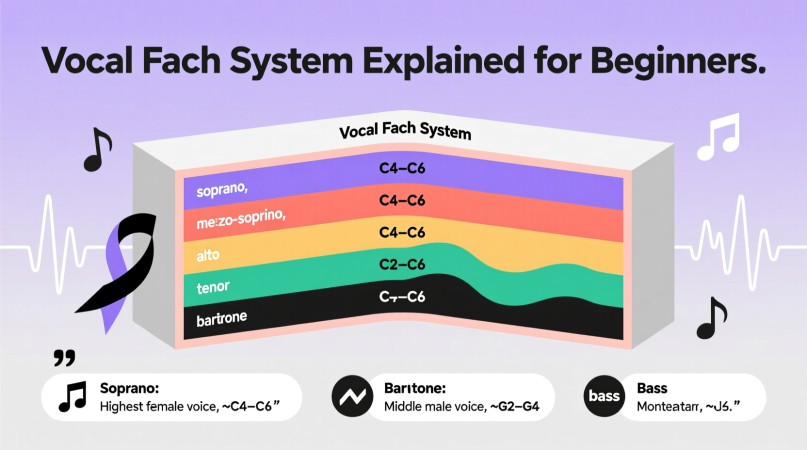
Finding your voice type can feel confusing, especially if you’re new to singing. Terms like soprano, tenor, or mezzo-soprano sound intimidating at first. That’s where the Fach system comes in—a framework that helps singers understand their natural vocal qualities.
This beginner-friendly guide explains what the Fach system is, why it matters, and how you can explore your own voice safely.
What Is the Vocal Fach System?
The word “Fach” is German for compartment or category. In singing, it describes a method of classifying voices so singers can perform music that matches their natural strengths.
Unlike simply measuring how high or low you can sing, the Fach system looks at:
- Vocal range – the highest and lowest notes you can sing.
- Tessitura – the “sweet spot” where your voice feels most comfortable.
- Timbre (tone quality) – whether your sound is light, bright, warm, or dark.
- Flexibility – how agile your voice is when moving between notes.
For beginners, think of Fach as a guidebook for your voice. It’s not about limiting creativity—it’s about singing in a way that feels natural and sustainable.
The Six Main Voice Types in the Fach System
While classical opera uses over 25 subcategories, most beginners only need to know the six core types:
Female Voices
- Soprano – The highest female voice; bright and agile.
- Mezzo-Soprano – Slightly lower, with a warmer tone.
- Contralto (Alto) – Deep and rich, the rarest female type.
Male Voices
- Tenor – The highest male voice; powerful and ringing.
- Baritone – Smooth, versatile, and the most common male type.
- Bass – The lowest, resonant and commanding.
Here’s a quick reference chart you can bookmark:
| Voice Type | Comfortable Range (approx.) | Sound Quality | Famous Example |
|---|---|---|---|
| Soprano | C4 – C6 | Bright, agile | Maria Callas |
| Mezzo | A3 – A5 | Warm, rich | Adele |
| Contralto | F3 – F5 | Dark, deep | Cher |
| Tenor | C3 – B4 | Clear, ringing | Freddie Mercury |
| Baritone | G2 – G4 | Smooth, strong | Josh Groban |
| Bass | E2 – E4 | Deep, resonant | Barry White |
Range vs. Tessitura: Why Comfort Matters More Than Extremes
A common beginner mistake is focusing only on the absolute high and low notes you can hit. But the Fach system emphasizes tessitura—the range where your voice feels effortless.
For example, you might be able to sing a high C once or twice, but if most songs feel best around G4, your Fach will lean toward a category that fits that comfort zone.
👉 Want to try it out? Use the Vocal Range Calculator to see both your extremes and your natural “sweet spot.”
Why the Fach System Matters (Even Beyond Opera)
- Protects your voice: Singing in the wrong range can cause strain and fatigue.
- Helps with song choice: Knowing your Fach makes picking repertoire easier.
- Guides your training: Teachers use Fach to tailor exercises to your needs.
- Cross-genre relevance: Even in pop, rock, or musicals, understanding range and tessitura helps you sing smarter.
Opera casting is strict about Fach categories, but modern music is more flexible. Think of it as a guideline, not a rulebook.
How to Explore Your Own Fach
If you’re a beginner, here’s a safe way to start:
- Warm up gently. Never push your voice to extremes.
- Find your lowest and highest comfortable notes.
- Notice your tessitura. Which part of your range feels natural?
- Compare with common voice types. Use the chart above.
- Check your results with tools. The free Vocal Range Test is a great starting point.
- Ask a vocal coach. Fach can shift as your voice develops.
FAQs: Vocal Fach System Basics
1. What does “Fach” mean in singing?
It’s a German term meaning “category,” used to classify voices by range, tessitura, and tone.
2. How many Fach categories are there?
In opera, over 25. Beginners only need to know the six main types.
3. Can your Fach change over time?
Yes. Age, training, and vocal maturity can shift your Fach.
4. Is the Fach system only for opera singers?
No. While developed for opera casting, it helps singers in all genres avoid strain and choose better songs.
5. How do I know my Fach?
Start with a range test, observe your tessitura, and confirm with a teacher.
